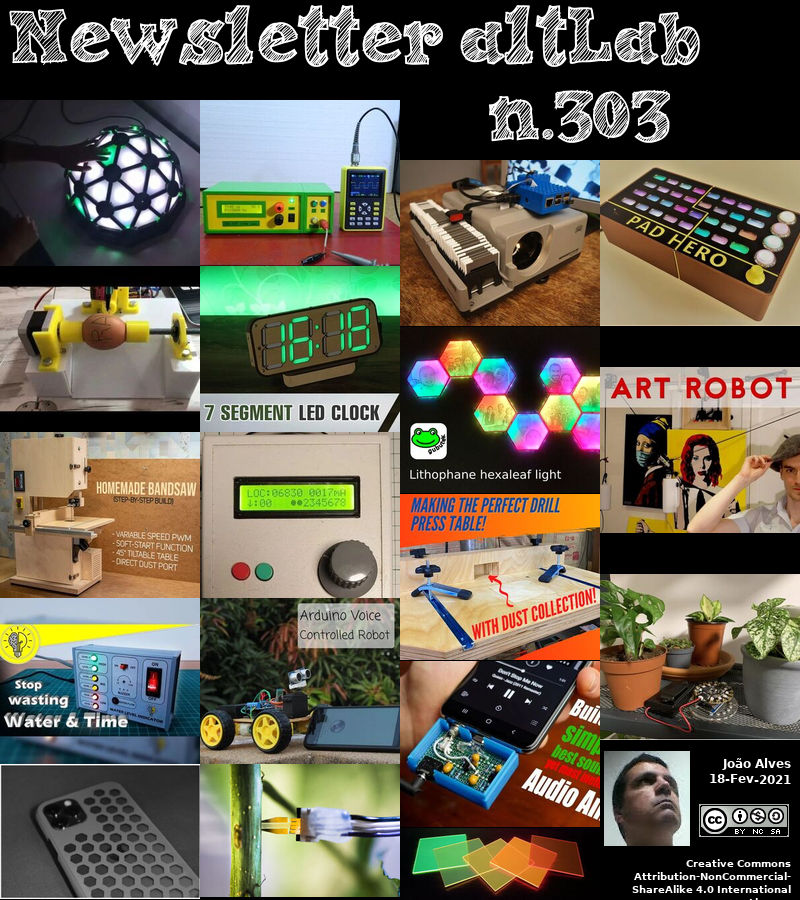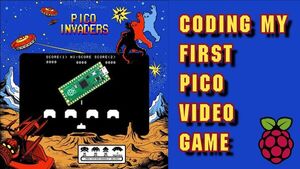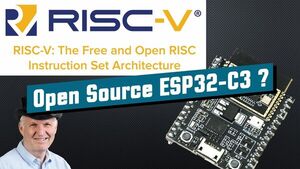2021-02-18 - Nº 303
Editorial
Esta é a Newsletter Nº 303 que se apresenta com o mesmo formato que as anteriores. Se gostar da Newsletter partilhe-a!
Todas as Newsletters encontram-se indexadas no link.
Esta Newsletter tem os seguintes tópicos:
Faz hoje anos que nascia, em 1201, o filósofo, cientista, matemático e astrónomo persa Nasir al-Din al-Tusi. Ele fez contribuições notáveis na sua época. Quando a invasão mongol, iniciada por Genghis Khan, o alcançou em 1256, ele escapou da provável morte juntando-se aos vitoriosos mongóis como conselheiro científico. Ele usou um observatório construído em Maragheh (concluído em 1262), assistido por astrónomos chineses. Ele tinha vários instrumentos, como um quadrante de parede de 4 metros feito de cobre e um quadrante de azimute que foi invenção do próprio Tusi. Usando movimentos planetários desenhados com precisão, ele modificou o modelo do sistema planetário de Ptolomeu baseado em princípios mecânicos. O observatório e a sua biblioteca tornaram-se um centro para uma ampla gama de trabalhos em ciências, matemática e filosofia. Ele era conhecido pelo título de Tusi pelo seu local de nascimento (Tus).
Faz também hoje anos que nascia, em 1745, o físico italiano Alessandro Volta. Ele inventou a bateria eléctrica (1800), que foi o primeiro fornecimento confiável e sustentado de corrente. A sua pilha voltaica usava placas de dois metais diferentes e um electrólito, vários discos alternados de zinco e prata, cada um separado por papelão embebido em salmoura porosa. Anteriormente, apenas a descarga de electricidade estática estava disponível, então o seu dispositivo permitia novos usos de electricidade. (Logo, com a electrólise, William Nicholson decompôs a água e Humphry Davy isolou o potássio e outros metais.) Volta também inventou o electróforo, o condensador e o electroscópio. Ele contribuiu para a meteorologia, estudou gases e descobriu o metano. O volt, uma unidade de medida da tensão eléctrica, tem o seu nome.
Faz igualmente hoje anos que nascia, em 1838, o físico e filósofo austríaco Ernst Mach. Ele estabeleceu princípios importantes de óptica, mecânica e dinâmica de ondas. Os seus primeiros trabalhos físicos foram dedicados à descarga eléctrica e indução. Entre 1860 e 1862, ele estudou em profundidade o Efeito Doppler por meio de experiências ópticas e acústicas. Ele introduziu o “número de Mach” para a relação entre a velocidade do objecto e a velocidade do som que recebeu seu nome. Quando os aviões supersónicos viajam hoje, sua velocidade é medida em termos que mantêm o nome de Mach vivo. O seu interesse profundo, no entanto, foi em psicologia e percepção humana. Ele apoiou que a visão de que todo conhecimento é uma organização conceptual dos dados da experiência sensorial (ou observação).
Faz também hoje anos que nascia, em 1871, o estatístico escocês Udny Yule. Ele, juntamente com Karl Pearson, estudou as estatísticas de regressão e correlação, especialmente as aplicadas em tabelas de contingência 2x2, séries temporais, genética mendeliana e epidemiologia. O seu nome é lembrado na distribuição de Yule (uma lei de potência discreta). O primeiro artigo de Yule sobre estatísticas, On the Correlation of Total Pauperism with Proportion of Out-relief (1895), reflecte seu interesse inicial em estatísticas aplicadas a problemas sociais. Como um dos pioneiros da estatística moderna, ele lançou uma base sobre a qual outros posteriormente construíram. Yule também fez algumas declarações pioneiras sobre os testes mentais, como reduzir o erro de medição e, assim, melhorar a validade. Desenvolvido a partir de sua série anterior de palestras, ele escreveu um livro-texto amplamente utilizado, Introdução à Estatística (1911), que teve 14 edições.
Por fim, faz hoje anos que nascia, em 1871, o Metalúrgico inglês Harry Brearley. Ele é responsável pela invenção do aço inoxidável, que é uma liga de aço com cromo e níquel. Em 1912, ele estava a investigar a corrosão de canos de espingardas porque o seu diâmetro interno foi rapidamente corroído pela acção do aquecimento e da descarga de gases. A sua solução foi desenvolver uma liga de aço com cromo que fosse muito mais resistente à ferrugem do que o aço de uso comum. Os metais adicionados produzem uma película superficial de óxidos metálicos que resiste à ferrugem. Portanto, foi denominado aço inoxidável. Ele também percebeu como isso poderia revolucionar a indústria da cutelaria. Até então, os talheres de mesa eram banhados a prata ou níquel e as facas de corte de aço carbono tinham que ser bem lavadas e secas após o uso, e mesmo assim as manchas de ferrugem teriam que ser removidas.
Nesta semana que passou foi lançada mais uma versão do Kernel Linux. Linus Torvalds lançou no passado domingo dia 14 a versão 5.11 do Kernel de Linux. Esta versão não é LTS, sendo no entanto a primeira lançada em 2021. De entre as principais mudanças destaca-se o suporte para Wi-Fi 6, melhorias no desempenho dos CPU AMD, suporte gráfico Intel Iris Xe, suporte AMD Van Gogh APU e muito mais. Foram também introduzidas melhorias significativas e suporte para a arquitectura de CPU RISC-V, incluindo suporte OpenRISC para o driver do controlador LiteX SoC e suporte geral para o SoC.
Hoje ao inicio da noite aterrou com sucesso o rover Perseverance na superfície de Marte. Lançado a bordo do foguetão Atlas V a 30 de Julho de 2020, foi a terceira sonda a chegar a Marte no espaço de 1 semana. O Rover Perseverance acompanhado pelo drone Ingenuity irão agora explorar a superfície de Marte, conduzindo um conjunto muito alargado de experiências e a tentativa de extracção de amostras para que possam no futuro ser enviadas para a Terra para serem estudadas. "O rover Perseverance é o geólogo robótico mais sofisticado já construído, mas verificar se a vida microscópica já existiu carrega um enorme ónus de prova", disse Lori Glaze, directora da Divisão de Ciência Planetária da NASA. “Embora possamos aprender muito com os grandes instrumentos que temos a bordo do rover, pode muito bem exigir que laboratórios e instrumentos muito mais capazes aqui na Terra nos digam se nossas amostras carregam evidências de que Marte já abrigou vida.
Na Newsletter desta semana apresentamos diversas noticias, artigos científicos assim como projetos de maker. É apresentada a revista HackSpace nº 40 de Março e os livros "Making Servers Work" e "Foundations of Machine Learning, Second Edition". Nesta semana abrimos uma nova secção com vídeos que apresentam projectos ou que abordam assuntos que são interessantes.
 João Alves ([email protected])
João Alves ([email protected])
O conteúdo da Newsletter encontra-se sob a licença  Creative Commons Attribution-NonCommercial-ShareAlike 4.0 International License.
Creative Commons Attribution-NonCommercial-ShareAlike 4.0 International License.
Novidades da Semana

Linux Kernel 5.11 Released With Support for Wi-Fi 6E, RTX ‘Ampere’ GPUs, Intel Iris Xe and More
"The development of Linux Kernel 5.11 has been going on in full swing for a while now. Finally, Linus Torvalds announced the release after endless testing and adding support for new software and hardware. Linus also mentioned: In fact, it’s a smaller-than-average set of commits from rc7 to final, which makes me happy. And I already have several pull requests lined up for tomorrow, so we’re all set for the merge window to start. But in the meantime – and yes, I know it’s Valentine’s Day here in the US – maybe give this release a good testing before you go back and play with development kernels. All right?" [...]
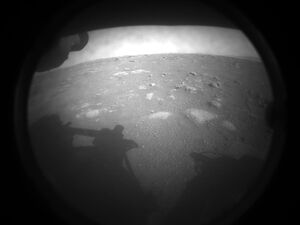
Touchdown! NASA’s Mars Perseverance Rover Safely Lands on Red Planet
"The agency’s latest and most complex mission to the Red Planet has touched down at Jezero Crater. Now it’s time to begin testing the health of the rover. The largest, most advanced rover NASA has sent to another world touched down on Mars Thursday, after a 203-day journey traversing 293 million miles (472 million kilometers). Confirmation of the successful touchdown was announced in mission control at NASA’s Jet Propulsion Laboratory in Southern California at 3:55 p.m. EST (12:55 p.m. PST). Packed with groundbreaking technology, the Mars 2020 mission launched July 30, 2020, from Cape Canaveral Space Force Station in Florida. The Perseverance rover mission marks an ambitious first step in the effort to collect Mars samples and return them to Earth." [...]
Outras Notícias
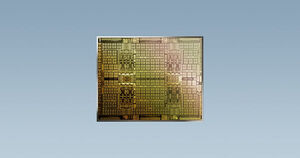
GeForce Is Made for Gaming, CMP Is Made to Mine
"We’re limiting the hash rate of GeForce RTX 3060 GPUs so they’re less desirable to miners and launching NVIDIA CMP for professional mining. We are gamers, through and through. We obsess about new gaming features, new architectures, new games and tech. We designed GeForce GPUs for gamers, and gamers are clamoring for more. Yet NVIDIA GPUs are programmable. And users are constantly discovering new applications for them, from weather simulation and gene sequencing to deep learning and robotics." [...]
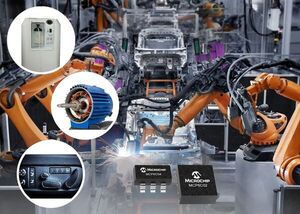
Microchip Delivers Accuracy and Energy-efficiency of Current Monitoring in High-temperature Automotive Applications
"New high-side current sense amplifier offers the industry’s lowest offset for AEC-Q100 Grade 0 qualified devices, enabling a more accurate and energy efficient current measurement solution for those applications exposed to extreme temperatures With the proliferation of automation and connectivity throughout the automotive and industrial markets, the need to accurately measure a dynamic current in the presence of high frequency noise often plagues modern vehicle and factory applications. In order to combat electrically noisy environments and address the need for higher accuracy current measurement, Microchip Technology Inc. (Nasdaq: MCHP) today introduced its high-side current sense amplifiers — featuring the industry’s lowest offset for AEC-Q100 Grade 0 qualified high-side current sense amplifier devices. AEC-Q100 qualified, the MCP6C02 amplifier is offered in both a Grade 1 6-pin SOT-23 package and a Grade 0 8-pin 3x3 VDFN package. Delivering a maximum offset error of only 12 µV, the VDFN package offers the lowest offset voltage for any Grade 0 high-side current sense amplifier. Specified over a temperature range of -40°C to +150°C, its market-leading offset error allows the use of smaller value shunt resistors while also maintaining a high measurement resolution. This enables a more accurate and energy efficient current measurement solution for those applications exposed to extreme temperatures, like the motor within a vehicle’s water pump." [...]

Toshiba Announces 18TB MG09 Series Hard Disk Drives
"Toshiba Electronic Devices & Storage Corporation (Toshiba) announces the 18TB[1] MG09 Series HDD, Toshiba’s first HDD models with energy-assisted magnetic recording. The MG09 Series features Toshiba’s third-generation, 9-disk Helium-sealed design and Toshiba’s innovative Flux Control – Microwave Assisted Magnetic Recording (FC-MAMR) technology, to advance Conventional Magnetic Recording (CMR) density to 2TB per disk, achieving a total capacity of 18TB. Sample shipments of 18TB MG09 Series HDD to customers are expected to start sequentially at the end of March 2021. With 12.5% more capacity than prior 16TB models, 18TB MG09 CMR drives are compatible with the widest range of applications and operating systems. The MG09 are adapted to mixed random and sequential read and write workloads in both cloud-scale and traditional data center use cases. The MG09 features 7,200rpm performance, a 550TB per year workload rating[2], and a choice of SATA and SAS interfaces—all in a power-efficient Helium-sealed industry-standard, 3.5-inch[3] form factor." [...]
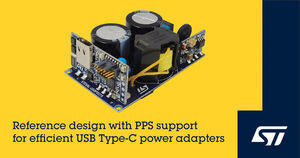
STMicroelectronics Eases Design of USB Type-C™ Power Adapters with Highly Efficient Power Delivery and PPS Reference Design
"STMicroelectronics has revealed a USB Type-C™ Power Delivery 3.0 reference design with Programmable Power Supply (PPS) support to accelerate the design of easy-to-use, compact, and efficient power adapters up to 27W with zero-power operation when no cable is connected. USB PPS helps to save power, and reduce device-charging times and heat dissipation, contributing also to cut bill-of-materials costs on the device side. The STEVAL-USBPD27S reference design combines the STM32G071 microcontroller (MCU), which integrates a complete USB Type-C Power Delivery controller on-chip, with the STCH03 state-of-the-art PWM controller and TCPP01-M12 USB Type-C protection IC. With this reference design, users can quickly build fast-charging USB power adapters that meet the stringent European CoC version 5 Tier-2 and US DOE Level VI requirements for minimum four-point average efficiency in active mode and standby power below 40mW. The STM32G071 MCU handles the entire digital control section, including the algorithm to control VBUS on the secondary side as well as ST’s unique and patented algorithm for adaptive synchronous rectification, which enhances energy efficiency. The VBUS-control algorithm meets the USB Type-C Power Delivery and PPS specifications and implements cable-drop compensation for precise control of the supplied voltage." [...]

SpaceX launches 60 more Starlink satellites but attempted landing of booster fails
"Running a day late because of bad weather, a SpaceX Falcon 9 rocket boosted 60 more Starlink internet satellites into orbit late Monday from Cape Canaveral. An attempt to recover the first stage with a landing on an off-shore droneship failed, ending a string of 24 successes in a row. Another Starlink launch, with another 60 satellites on board, is planned for early Wednesday from the nearby Kennedy Space Center as SpaceX presses ahead with building out a globe-spanning constellation designed to deliver internet access to customers around the world. What impact, if any, the landing mishap might have on Wednesday's flight is not yet known. Monday's flight got off to a spectacular start at 10:59 p.m. EST when the Falcon 9 rocket's nine first stage engines ignited with a burst of fire, 229 pushing the 229-foot-tall booster away from pad 40 at the Cape Canaveral Space Force Station. Generating 1.7 million pounds of thrust, the engines powered the rocket away on a northeasterly trajectory, rapidly accelerating as they consumed propellants and the vehicle lost weight." [...]
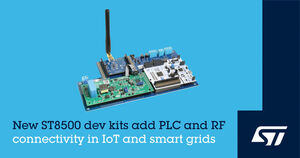
STMicroelectronics Drives G3-PLC Hybrid Connectivity into Smart Devices with ST8500 Development Ecosystem
"To accelerate G3-PLC Hybrid connectivity in smart-grid and IoT devices, STMicroelectronics has revealed a development ecosystem for its ST8500 programmable power-line communication (PLC) modem chipset. Comprising two evaluation boards targeting 868MHz and 915MHz license-free RF bands, with documented firmware, the ecosystem helps users quickly build and test nodes that comply with G3-PLC Hybrid, the industry’s first published standard for dual PLC & RF connectivity. Equipment such as smart meters, environmental monitors, lighting controllers, and industrial sensors containing the ST8500 chipset, which supports G3-PLC Hybrid, can select the powerline or wireless channel autonomously and change dynamically to ensure the most reliable connection. Launched in 2019, the chipset combines the ST8500 protocol controller System-on-Chip (SoC), which runs ST’s G3-PLC Hybrid firmware, with the STLD1 powerline communication (PLC) line driver and S2-LP sub-GHz radio. Devices containing the chipset are backward-compatible and interoperable with any G3-PLC network. ST’s hybrid protocol stack is based on G3-PLC, IEEE 802.15.4, 6LowPAN and IPv6 open standards." [...]
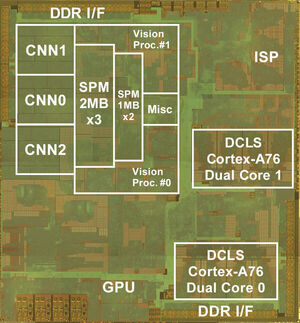
Renesas Develops Automotive SoC Functional Safety Technologies for CNN Accelerator Cores and ASIL D Control Combining World-Class Performance and Power Efficiency
"Delivers 60.4 TOPS and 13.8 TOPS/W in CNN Processing, Enabling Implementation of Main Processing Tasks for Autonomous Driving Systems on a Single Chip Renesas Electronics Corporation (TSE:6723), a premier supplier of advanced semiconductor solutions, today announced the development of processor technologies for automotive systems-on-chip (SoCs) used in applications such as advanced driver assistance systems (ADAS) and autonomous driving (AD) systems that aim to optimize both performance and power efficiency while supporting a high level of functional safety. Renesas’ successful development announced today includes: 1) A convolutional neural network (CNN) hardware accelerator core that delivers a world-class combination of deep learning performance of 60.4 trillion operations per second (TOPS) and a power efficiency of 13.8 TOPS/W; 2) sophisticated safety mechanisms for fast detection of and response to random hardware failures. This makes it possible to create a highly power efficient detection mechanism with a high failure detection rate; 3) A mechanism that allows software tasks with different safety levels to operate in parallel on the SoC without interfering with each other, thereby bolstering functional safety for ASIL D control. These technologies have been applied in the company’s latest R-Car V3U automotive SoC. Renesas presented these achievements at the International Solid-State Circuits Conference 2021 (ISSCC 2021), which took place February 13 to 22, 2021. Applications such as next-generation ADAS and AD systems require outstanding deep learning performance of 60 TOPS or even 120 TOPS alongside power efficiency." [...]
ON Semiconductor Announce New 650V Silicon Carbide MOSFETs
"ON Semiconductor (Nasdaq:ON), driving energy efficient innovations, has announced a new range of silicon carbide (SiC) MOSFET devices for demanding applications where power density, efficiency and reliability are key considerations. By replacing existing silicon switching technologies with the new SiC devices, designers will achieve significantly better performance in applications such as electric vehicles (EV) on-board chargers (OBC) , solar inverters , server power supply units (PSU) , telecoms and uninterruptible power supplies (UPS) . ON Semiconductor’s new automotive AECQ101 and industrial grade qualified 650 volt (V) SiC MOSFETs are based upon a new wide bandgap material that provides superior switching performance and improved thermals when compared to silicon. This results in improved efficiency at the system level, enhanced power density, reduced electromagnetic interference (EMI) and reduced system size and weight. The new generation of SiC MOSFETs employ a novel active cell design combined with advanced thin wafer technology enabling best in class figure of merit Rsp (Rdson*area) for 650 V breakdown voltage. The NVBG015N065SC1 , NTBG015N065SC1, NVH4L015N065SC1 and NTH4L015N065SC1 have the lowest Rdson (12 mOhm) in the market in D2PAK7L and To247 packages." [...]
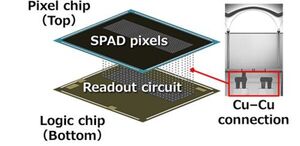
Sony Develops a Stacked Direct Time of Flight Depth Sensor for Automotive LiDAR with SPAD Pixels, an Industry First
"Sony Corporation announced today that it has developed a stacked direct Time of Flight (dToF) depth sensor for automotive LiDAR using single-photon avalanche diode (SPAD) pixels, an industry first. *1 This achievement was announced at the International Solid-State Circuits Conference (ISSCC), which opened on February 13, 2021. In addition to sensing devices such as cameras and millimeter wave radar, LiDAR is becoming ever more important as a method of high-precision detection and recognition of not only road conditions but also the location and shape of objects such as vehicles and pedestrians. This trend is being driven by the popularization of advanced driver assistance systems (ADAS) and the need for this technology in autonomous driving (AD). SPAD is a pixel structure that uses avalanche multiplication to amplify electrons from a single incident photon, causing a cascade like an avalanche, and it can detect even weak light. It is possible to accomplish long-distance, high-precision distance measuring by employing SPAD as the detector in a dToF sensor, which measures the distance to an object based on the time of flight (time difference) of a light emitted from a light source until it returns to the sensor, after being reflected by the object." [...]
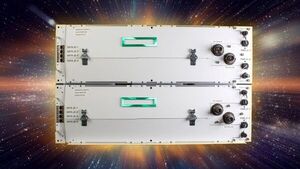
Hewlett Packard Enterprise accelerates space exploration with first ever in-space commercial edge computing and artificial intelligence capabilities
"Astronauts and researchers can process data at the edge and speed time-to-insight from months to minutes with launch of HPE’s Spaceborne Computer-2, an edge computing system for the International Space Station Hewlett Packard Enterprise (HPE) today announced it is accelerating space exploration and increasing self-sufficiency for astronauts by enabling real-time data processing with advanced commercial edge computing in space for the first time. Astronauts and space explorers aboard the International Space Station (ISS) will speed time-to-insight from months to minutes on various experiments in space, from processing medical imaging and DNA sequencing to unlocking key insights from volumes of remote sensors and satellites, using HPE’s Spaceborne Computer-2 (SBC-2), an edge computing system. Spaceborne Computer-2 is scheduled to launch into orbit on the 15th Northrop Grumman Resupply Mission to Space Station (NG-15) on February 20 and will be available for use on the International Space Station for the next 2-3 years. The NG-15 spacecraft has been named “SS. Katherine Johnson” in honor of Katherine Johnson, a famed Black, female NASA mathematician who was critical to the early success of the space program. Breaking Barriers to Achieve Reliable Computing in Space The upcoming launch of Spaceborne Computer-2 builds on the proven success of its predecessor, Spaceborne Computer, a proof-of-concept that HPE developed and launched in partnership with NASA in 2017 to operate on the International Space Station (ISS) for a one-year mission." [...]
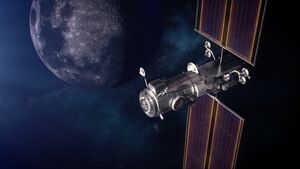
NASA Awards Contract to Launch Initial Elements for Lunar Outpost
"NASA has selected Space Exploration Technologies (SpaceX) of Hawthorne, California, to provide launch services for the agency’s Power and Propulsion Element (PPE) and Habitation and Logistics Outpost (HALO), the foundational elements of the Gateway. As the first long-term orbiting outpost around the Moon, the Gateway is critical to supporting sustainable astronauts missions under the agency’s Artemis program. After integration on Earth, the PPE and HALO are targeted to launch together no earlier than May 2024 on a Falcon Heavy rocket from Launch Complex 39A at NASA’s Kennedy Space Center in Florida. The total cost to NASA is approximately $331.8 million, including the launch service and other mission-related costs. The PPE is a 60-kilowatt class solar electric propulsion spacecraft that also will provide power, high-speed communications, attitude control, and the capability to move the Gateway to different lunar orbits, providing more access to the Moon’s surface than ever before. The HALO is the pressurized living quarters where astronauts who visit the Gateway, often on their way to the Moon, will work." [...]
Ciência e Tecnologia

Nanowire could provide a stable, easy-to-make superconducting transistor
"Inspired by decades-old MIT research, the new technology could boost quantum computers and other superconducting electronics. Superconductors — materials that conduct electricity without resistance — are remarkable. They provide a macroscopic glimpse into quantum phenomena, which are usually observable only at the atomic level. Beyond their physical peculiarity, superconductors are also useful. They’re found in medical imaging, quantum computers, and cameras used with telescopes. But superconducting devices can be finicky." [...]

The light side of the Force
"A group of researchers from the Fritz Haber Institute of the Max Planck Society and the Humboldt-Universität zu Berlin have found out that a semiconductor can be converted to a metal and back by light more easily and more quickly than previously thought. This discovery may increase the processing speed and simplify the design of many common technological devices. From smartphones to computer processors – much of the technology we nowadays use heavily features transistors. They connect many of the different materials that make up these devices, and are essential for any kind of data processing. Because they are so important, scientists and engineers have long tried to optimize them by modifying their material properties, so that they can be used more flexibly. Now, a team of researchers the Fritz Haber Institute of the Max Planck Society and the Humboldt-Universität zu Berlin has found an important clue on how to achieve that." [...]

Breakthrough in Quantum Photonics Promises a New Era in Optical Circuits
"A world-first method to enable quantum optical circuits that use photons—light particles—heralds a new future for secure communication and quantum computing. The modern world is powered by electrical circuitry on a “chip”—the semiconductor chip underpinning computers, cell phones, the internet, and other applications. In the year 2025, humans are expected to be creating 175 zettabytes (175trillion gigabytes) of new data. How can we ensure the security of sensitive data at such a high volume? And how can we address grand-challenge-like problems, from privacy and security to climate change, leveraging this data, especially given the limited capability of current computers? A promising alternative is emerging quantum communication and computation technologies." [...]

Portrait of young galaxy throws theory of galaxy formation on its head
"A team led by KICC visitor Dr Federico Lelli has peered 12 billion years into the past, revealing a distant galaxy with an unexpected appearance. Scientists have challenged our current understanding of the way galaxies form by unveiling pictures of a young galaxy in the early life of the Universe which appears surprisingly mature. The galaxy, dubbed ALESS 073.1, appears to have all of the features expected of a much more mature galaxy and has led the team of scientists to question how it grew so fast. The new research has been published today in Science. Galaxies come in a variety of shapes, sizes and colours, and are made up of different components such as rotating disks, spiral arms, and "bulges". A major goal of present-day astronomy is understanding why different galaxies look the way they are today and when their different components formed." [...]
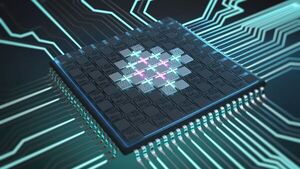
Technologies for More Powerful Quantum Computers
"Quantum computers will efficiently solve problems that could not be solved in the past. Examples are calculations of properties of complex molecules for pharmaceutical industry or solutions of optimization problems for manufacturing processes in automotive industry or for calculations in the financial sector. Within the framework of the “GeQCoS“ collaboration project, Germany’s leading researchers in the area of superconducting quantum circuits are working on innovative concepts for designing better quantum processors. Researchers from Karlsruhe Institute of Technology (KIT) play an important role in the project. The collaboration project “German Quantum Computer Based on Superconducting Qubits,” GeQCoS for short, is aimed at developing a prototype quantum processor consisting of a few superconducting qubits with fundamentally improved components. The main components of a quantum computer, the quantum bits or qubits, will be implemented by zero-resistance currents in superconducting circuits." [...]

Blueprint for fault-tolerant qubits
"Scientists at Forschungszentrum Jülich and RWTH Aachen University have designed a circuit for quantum computers which is naturally protected against common errors Jülich, 18 February 2021 – Building a universal quantum computer is a challenging task because of the fragility of quantum bits, or qubits for short. To deal with this problem, various types of error correction have been developed. Conventional methods do this by active correction techniques. In contrast, researchers led by Prof. David DiVincenzo from Forschungszentrum Jülich and RWTH Aachen University, together with partners from the University of Basel and QuTech Delft, have now proposed a design for a circuit with passive error correction. Such a circuit would already be inherently fault protected and could significantly accelerate the construction of a quantum computer with a large number of qubits. In order to encode quantum information in a reliable way, usually, several imperfect qubits are combined to form a so-called logical qubit." [...]

Biosensors monitor plant well-being in real time
"Researchers at Linköping University have developed biosensors that make it possible to monitor sugar levels in real time deep in the plant tissues – something that has previously been impossible. The information from the sensors may help agriculture to adapt production as the world faces climate change. The primary source of nutrition for most of the Earth’s population is mainly plants, which are also the foundation of the complete ecosystem on which we all depend. Global population is rising, and rapid climate change is at the same time changing the conditions for crop cultivation and agriculture. “We will have to secure our food supply in the coming decades. And we must do this using the same, or even fewer, resources as today." [...]
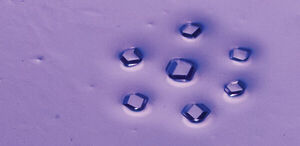
Locked MOFs are the key to high porosity
"Sophisticated geometry design gives rise to a new form of crystalline material. A highly porous metal organic framework, assembled from molecular building blocks designed to lock together in a specific orientation, has been developed by researchers at KAUST. Metal organic frameworks (MOFs) are crystalline materials made from metal ions connected by organic linkers. Their internal structure is like a repeating array of tiny identical cages, which are ideal for hosting various molecules. MOFs have found potential uses from gas sensing to molecular separations to storage, depending on the dimensions and structure of their pores. One family of MOFs has been inspired by inorganic porous materials called zeolites." [...]
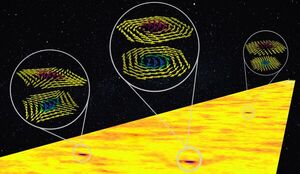
Researchers from NUS create ‘whirling’ nano-structures in anti-ferromagnets
"Today’s digital world generates vast amounts of data every second. Hence, there is a need for memory chips that can store more data in less space, as well as the ability to read and write that data faster while using less energy. Researchers from the National University of Singapore (NUS), working with collaborators from the University of Oxford, Diamond Light Source (the United Kingdom’s national synchrotron science facility) and University of Wisconsin Madison, have now developed an ultra-thin material with unique properties that could eventually achieve some of these goals. Their results were first published online in the journal Nature on 4 February 2021. Storing data in anti-ferromagnets In existing ferromagnet memory devices like hard drives, information is stored into specific patterns of atoms (called bits), within which all the little magnetic poles are oriented in the same direction. This arrangement makes them slow and susceptible to damage by stray magnetic fields." [...]

Research helps solar technology become more affordable
"Scientists at The University of Manchester have found a way to accelerate the uptake of solar technology, by increasing the environmental safety of perovskite solar cells. Perovskite solar cells have attracted interest because, unlike silicon solar cells, they can be mass produced through roll-to-roll processing. Additionally, they are light and colourful, with the versatility to be used in non-traditional settings such as windows and contoured roofs. However, up until now, application has been impacted by potential environmental risks. Perovskite solar cells contain lead, a cumulative toxin, and if the cells get damaged, lead ions may leak. Taking lessons from nature, Professor Brian Saunders and Dr David Lewis have devised a way to eliminate the lead release from broken cells." [...]

Luminescent windows generate energy from inside and out
"Rice engineers develop polymer cores that redirect light from any source to solar cells Rice University engineers have suggested a colorful solution to next-generation energy collection: Luminescent solar concentrators (LSCs) in your windows. Led by Rafael Verduzco and postdoctoral researcher and lead author Yilin Li of Rice’s Brown School of Engineering, the team designed and built foot-square “windows” that sandwich a conjugated polymer between two clear acrylic panels. That thin middle layer is the secret sauce. It’s designed to absorb light in a specific wavelength and guide it to panel edges lined with solar cells. Conjugated polymers are chemical compounds that can be tuned with specific chemical or physical properties for a variety of applications, like conductive films or sensors for biomedical devices. The Rice lab’s polymer compound is called PNV (for poly[naphthalene-alt-vinylene]) and absorbs and emits red light, but adjusting the molecular ingredients should make it able to absorb light in a variety of colors." [...]

ITMO Scientists Come up With a Way To Protect Satellites From Space Radiation
"The scientists suggested a new material for power electronics for use on orbital spacecrafts. It’s a semiconductor based on gallium oxides and aluminum that is better at resisting space radiation. An article about it was published in Acta Astronautica. Earth is surrounded by artificial satellites with various purposes, including scientific, military, and communicative. In 2020, a public organization Union of Concerned Scientists assembled a satellite database with almost 2800 operational satellites that are currently orbiting the Earth. Each year, this number grows." [...]
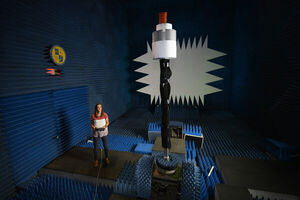
New NRL 3D-printed antenna designs reduce cost, weight and size
"U.S. Naval Research Laboratory experts created and tested 3D-printed antennas and arrays to advance radar technology and enable new applications for the U.S. Navy. The lightweight and rapid production of 3D-printed parts make it an attractive alternative to traditional manufacturing that often requires expensive materials and specialized equipment. “3D printing is a way to produce rapid prototypes and get through multiple design iterations very quickly, with minimal cost,” said NRL electrical engineer Anna Stumme. “The lightweight of the printed parts also allows us to take technology to new applications, where the heavyweight of solid metal parts used to restrict us.” Radar systems perform critical functions for the Navy, and remain an important part of maritime navigation and national defense. Parts for antennas and arrays, which are multiple connected antennas working together as one, may unexpectedly break or wear out requiring replacement." [...]

Mystery of amorphous perovskite solved
"AMOLF researchers Erik Garnett, Susan Rigter, and colleagues are the first to have irrefutably demonstrated that amorphous perovskite exists. The material can significantly increase the efficiency of solar cells produced from perovskite. The research is published today online in the journal Advanced Functional Materials. Perovskite, the highly promising new material for solar cells, is naturally crystalline; in other words, the atoms pack together in an ordered pattern. From traditional silicon solar cells, we know that the efficiency of the cells can be boosted if a part of the material is amorphous, meaning the atoms pack together randomly. Erik Garnett (AMOLF Nanoscale Solar Cells) was the first to realize that amorphous perovskite could fulfill the same function." [...]
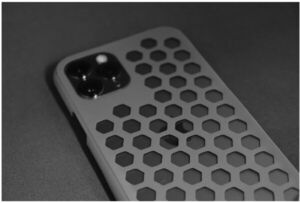
More sustainable recycling of plastics
"Chemists at the University of Konstanz have developed a method for more sustainable recycling of polyethylene-like plastics Plastics belong to the most widely used materials, and they are vital components of all modern technologies. So far, it has been possible to recycle these valuable materials only to a limited extent. In order to offer novel solutions, chemists of Professor Stefan Mecking’s group at the University of Konstanz developed a more sustainable method for chemically recycling polyethylene-like plastics. The researchers use “breaking-points” on a molecular level to disassemble the plastic back to its molecular components. The new method works without extremely high temperatures, is therefore more energy-efficient and has a significantly higher recovery rate (approx. 96 per cent of the starting material) than established processes." [...]

This robot doesn’t need any electronics
"Engineers at the University of California San Diego have created a four-legged soft robot that doesn’t need any electronics to work. The robot only needs a constant source of pressurized air for all its functions, including its controls and locomotion systems. The team, led by Michael T. Tolley, a professor of mechanical engineering at the Jacobs School of Engineering at UC San Diego, details its findings in the Feb. 17, 2021 issue of the journal Science Robotics. “This work represents a fundamental yet significant step towards fully-autonomous, electronics-free walking robots,” said Dylan Drotman, a Ph.D. student in Tolley’s research group and the paper’s first author. Applications include low-cost robotics for entertainment, such as toys, and robots that can operate in environments where electronics cannot function, such as MRI machines or mine shafts. Soft robots are of particular interest because they easily adapt to their environment and operate safely near humans." [...]

Quantum collaboration gives new gravity to the mysteries of the Universe
"Scientists have used cutting-edge research in quantum computation and quantum technology to pioneer a radical new approach to determining how our Universe works at its most fundamental level. An international team of experts, led by the University of Nottingham, have demonstrated that only quantum and not classical gravity could be used to create a certain informatic ingredient that is needed for quantum computation. Their research “Non-Gaussianity as a signature of a quantum theory of gravity” has been published today in PRX Quantum. Dr Richard Howl led the research during his time at the University of Nottingham’s School of Mathematics, he said: “For more than a hundred years, physicists have struggled to determine how the two foundational theories of science, quantum theory and general relativity, which respectively describe microscopic and macroscopic phenomena, are unified into a single overarching theory of nature. During this time, they have come up with two fundamentally contrasting approaches, called ‘quantum gravity’ and ‘classical gravity’. However, a complete lack of experimental evidence means that physicists do not know which approach the overarching theory actually takes, our research provides an experimental approach to solving this.” This new research, which is a collaboration between experts in quantum computing, quantum gravity, and quantum experiments finds an unexpected connection between the fields of quantum computing and quantum gravity and uses this to propose a way to test experimentally that there is quantum not classical gravity." [...]
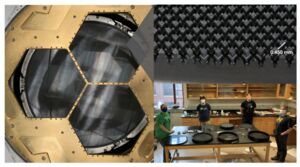
New metamaterials for studying the oldest light in the universe
"The cosmic microwave background, or CMB, is the electromagnetic echo of the Big Bang, radiation that has been traveling through space and time since the very first atoms were born 380,000 years after our universe began. Mapping minuscule variations in the CMB tells scientists about how our universe came to be and what it’s made of. To capture the ancient, cold light from the CMB, researchers use specialized telescopes equipped with ultrasensitive cameras for detecting millimeter-wavelength signals. The next-generation cameras will contain up to 100,000 superconducting detectors. Fermilab scientist and University of Chicago Associate Professor Jeff McMahon and his team have developed a new type of metamaterials-based antireflection coating for the silicon lenses used in these cameras. “There are at least half a dozen projects that would not be possible without these,” McMahon said." [...]

Quantum computing: when ignorance is wanted
"Quantum technologies for computers open up new concepts of preserving the privacy of input and output data of a computation. Scientists from the University of Vienna, the Singapore University of Technology and Design and the Polytechnic University of Milan have shown that optical quantum systems are not only particularly suitable for some quantum computations, but can also effectively encrypt the associated input and output data. This demonstration of a so-called quantum homomorphic encryption of a quantum computation has now been published in "NPJ Quantum Information". Quantum computers promise not only to outperform classical machines in certain important tasks, but also to maintain the privacy of data processing. The secure delegation of computations has been an increasingly important issue since the possibility of utilizing cloud computing and cloud networks. Of particular interest is the ability to exploit quantum technology that allows for unconditional security, meaning that no assumptions about the computational power of a potential adversary need to be made." [...]
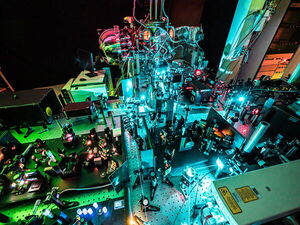
Ultrafast Electron Dynamics in Space and Time
"In textbooks and explanatory videos, they are often depicted as colourful balloons or clouds: electron orbitals provide information on the whereabouts of electrons in molecules, a bit like fuzzy snapshots. In order to understand the exchange of electrons in chemical reactions, it is not only important to know their spatial distribution but also to be able to trace their motion in time. Scientists from Jülich, Marburg, and Graz have now made huge progress in this direction. They combined state-of-the-art methods used in laser and electron spectroscopy and successfully recorded orbital images with an extremely high temporal resolution. Their findings were published today in the peer-reviewed journal Science. "For decades, chemistry has been governed by two ambitions goals," says Professor Stefan Tautz, head of the Quantum Nanoscience subinstitute at Forschungszentrum Jülich." [...]

Supercomputer Turns Back Cosmic Clock
"Astronomers have tested a method for reconstructing the state of the early Universe by applying it to 4000 simulated universes using the ATERUI II supercomputer at the National Astronomical Observatory of Japan (NAOJ). They found that together with new observations the method can set better constraints on inflation, one of the most enigmatic events in the history of the Universe. The method can shorten the observation time required to distinguish between various inflation theories. Just after the Universe came into existence 13.8 billion years ago, it suddenly increased more than a trillion, trillion times in size, in less than a trillionth of a trillionth of a microsecond; but no one knows how or why. This sudden “inflation,” is one of the most important mysteries in modern astronomy. Inflation should have created primordial density fluctuations which would have affected the distribution of where galaxies developed." [...]
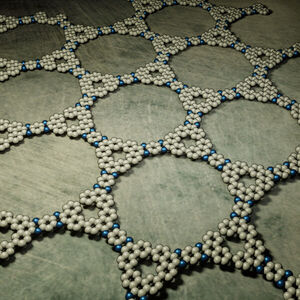
Kagome graphene promises exciting properties
"For the first time, physicists from the University of Basel have produced a graphene compound consisting of carbon atoms and a small number of nitrogen atoms in a regular grid of hexagons and triangles. This honeycomb-structured “kagome lattice” behaves as a semiconductor and may also have unusual electrical properties. In the future, it could potentially be used in electronic sensors or quantum computers. Researchers around the world are searching for new synthetic materials with special properties such as superconductivity — that is, the conduction of electric current without resistance. These new substances are an important step in the development of highly energy-efficient electronics. The starting material is often a single-layer honeycomb structure of carbon atoms (graphene)." [...]

A 'ground-breaking' solution to quake impact
"University of Technology Sydney researchers have developed a solution to protect buildings sitting on deep foundations from earthquakes resulting in surface fault ruptures. Their findings show a composite foundation system using inexpensive polymer materials can significantly improve the safety of infrastructure and substantially decrease fatality and damage due to large ground deformations. Surface rupturing during earthquakes is a significant risk to any structure that is built across a fault zone that may be active, in addition to any risk from ground shaking. Surface rupture can affect large areas of land, and it can damage all structures in the vicinity of the fracture. Although current seismic codes restrict the construction in the vicinity of active tectonic faults, finding the exact location of fault outcrop is often difficult. In many regions around the world, engineering structures such as earth dams, buildings, pipelines, landfills, bridges, roads and railroads have been built in areas very close to active fault segments." [...]

Graphene “nano-origami” creates tiniest microchips yet
"The tiniest microchips yet can be made from graphene and other 2D-materials, using a form of ‘nano-origami’, physicists at the University of Sussex have found. This is the first time any researchers have done this, and it is covered in a paper published in the ACS Nano journal. By creating kinks in the structure of graphene, researchers at the University of Sussex have made the nanomaterial behave like a transistor, and have shown that when a strip of graphene is crinkled in this way, it can behave like a microchip, which is around 100 times smaller than conventional microchips. Prof Alan Dalton in the School of Mathematical and Physical Sciences at the University of Sussex, said: “We’re mechanically creating kinks in a layer of graphene. It’s a bit like nano-origami. “Using these nanomaterials will make our computer chips smaller and faster." [...]
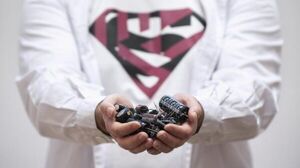
Highway tunnel for ions
"We live in modern times, that is full of electronics. Smartphones, laptops, tablets, and many other devices need electrical energy to operate. Portable devices made our lives easier, so novel solutions in clean energy and its storage are desirable. Lithium-ion (Li-ion) batteries are the most common solutions that dominate the global market and are a huge problem due to their insufficient recovery. Because of their limited power, short cycle life, and non-environment-friendly nature, scientists recently focused on novel solutions like supercapacitors that offer much more than batteries. Why?" [...]
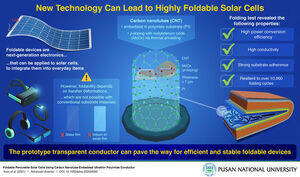
The Future of Solar Technology: New Technology Makes Foldable Cells a Practical Reality
"International research team creates solar cells with unprecedented flexibility and resistance With the recent development of foldable mobile phone screens, research on foldable electronics has never been so intensive. One particularly useful application of the foldable technology is in solar panels. Current solar cells are restricted to rigid, flat panels, which are difficult to store in large numbers and integrate into everyday appliances, including phones, windows, vehicles, or indoor devices. But, one problem prevents this formidable technology from breaking through: to be integrated into these items, solar cells need to be foldable, to bend at will repeatedly without breaking. Traditional conducting materials used in solar cells lack flexibility, creating a huge obstacle in developing fully foldable cells. A key requirement for an efficient foldable conductor is the ability to withstand the pressure of bending within a very small radius while maintaining its integrity and other desirable properties." [...]

Scientists manipulate magnets at the atomic scale
"Fast and energy-efficient future data processing technologies are on the horizon after an international team of scientists successfully manipulated magnets at the atomic level. Physicist Dr Rostislav Mikhaylovskiy from Lancaster University said: “With stalling efficiency trends of current technology, new scientific approaches are especially valuable. Our discovery of the atomically-driven ultrafast control of magnetism opens broad avenues for fast and energy-efficient future data processing technologies essential to keep up with our data hunger.” Magnetic materials are heavily used in modern life with applications ranging from fridge magnets to Google and Amazon’s data centers used to store digital information. These materials host trillions of mutually aligned elementary magnetic moments or “spins”, whose alignment is largely governed by the arrangement of the atoms in the crystal lattice. The spin can be seen as an elementary “needle of a compass”, typically depicted as an arrow showing the direction from North to South poles. In magnets all spins are aligned along the same direction by the force called exchange interaction." [...]

GreEnergy: setting a new paradigm for solar energy harvesting
"A new project funded by the European Commission through the Horizon 2020 Programme aims at developing optical nano-antennas as cost-effective solar energy harvester for a greener future. Most energy sources we use today have low efficiency, rely on non-renewable resources and cause severe damage to our planet by contributing to global warming. GreEnergy envisions the use of the cleanest energy source available: the sun. The sun is the world's most powerful and abundant energy resource, and offers a nearly unlimited supply of energy to our planet. However, according to the Joint Research Centre (JRC), current solar photovoltaics (PV) produce roughly 4% of the world’s electricity, due to their low efficiency and relatively high costs. GreEnergy’s ambition is to define a new paradigm in the field of solar energy harvesting, by prototyping a self-powering system based on optical nano-antennas which can harvest solar energy, rectify the AC signal and use it to charge a micro-supercapacitor." [...]

Light used to detect quantum information stored in 100,000 nuclear quantum bits
"Researchers have found a way to use light and a single electron to communicate with a cloud of quantum bits and sense their behaviour, making it possible to detect a single quantum bit in a dense cloud. The researchers, from the University of Cambridge, were able to inject a ‘needle’ of highly fragile quantum information in a ‘haystack’ of 100,000 nuclei. Using lasers to control an electron, the researchers could then use that electron to control the behaviour of the haystack, making it easier to find the needle. They were able to detect the ‘needle’ with a precision of 1.9 parts per million: high enough to detect a single quantum bit in this large ensemble. The technique makes it possible to send highly fragile quantum information optically to a nuclear system for storage, and to verify its imprint with minimal disturbance, an important step in the development of a quantum internet based on quantum light sources. The results are reported in the journal Nature Physics." [...]

Applying Quantum Computing to a Particle Process
"Berkeley Lab team models parton showers using a quantum algorithm. A team of researchers at Lawrence Berkeley National Laboratory (Berkeley Lab) used a quantum computer to successfully simulate an aspect of particle collisions that is typically neglected in high-energy physics experiments, such as those that occur at CERN’s Large Hadron Collider. The quantum algorithm they developed accounts for the complexity of parton showers, which are complicated bursts of particles produced in the collisions that involve particle production and decay processes. Classical algorithms typically used to model parton showers, such as the popular Markov Chain Monte Carlo algorithms, overlook several quantum-based effects, the researchers note in a study published online Feb. 10 in the journal Physical Review Letters that details their quantum algorithm. “We’ve essentially shown that you can put a parton shower on a quantum computer with efficient resources,” said Christian Bauer, who is Theory Group leader and serves as principal investigator for quantum computing efforts in Berkeley Lab’s Physics Division, “and we’ve shown there are certain quantum effects that are difficult to describe on a classical computer that you could describe on a quantum computer.” Bauer led the recent study. Their approach meshes quantum and classical computing: It uses the quantum solution only for the part of the particle collisions that cannot be addressed with classical computing, and uses classical computing to address all of the other aspects of the particle collisions." [...]
Documentação
A documentação é parte essencial do processo de aprendizagem e a Internet além de artigos interessantes de explorar também tem alguma documentação em formato PDF interessante de ler. Todos os links aqui apresentados são para conteúdo disponibilizado livremente pelo editor do livro.

HackSpace magazine #40
"So you’re got a Raspberry Pi Pico – what next? Explore some of the possibilities of this $4 microcontroller in the latest issue of HackSpace, that’s what! We’re going further with the Pico to give you more ideas and projects to get stuck into, and we won’t stop until the robot army is complete (or we run out of NeoPixels, which ever is sooner). Mix old tech (screen printing) with new (laser cutting) Control curves in FreeCAD How Sonic the Hedgehog 2 inspired a modular synth odyssey Go down the rabbit hole of crochet" [...]
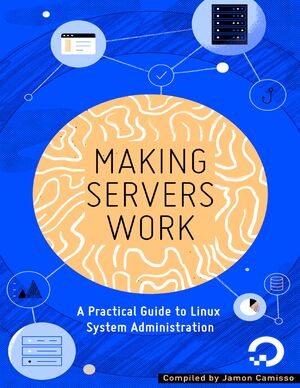
Making Servers Work
"This book highlights practical sysadmin skills, common architectures that you’ll encounter, and best practices that apply to automating and running systems at any scale, from one laptop or server to 1,000 or more. It is intended to help orient you within the discipline, and hopefully encourages you to learn more about system administration. This book is based on the Making Servers Work: A Practical Guide to Linux System Administration curriculum found on DigitalOcean Community. " [...]
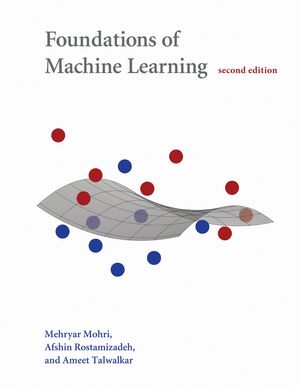
Foundations of Machine Learning, Second Edition
"This book is a general introduction to machine learning that can serve as a textbook for graduate students and a reference for researchers. It covers fundamental modern topics in machine learning while providing the theoretical basis and conceptual tools needed for the discussion and justification of algorithms. It also describes several key aspects of the application of these algorithms. The authors aim to present novel theoretical tools and concepts while giving concise proofs even for relatively advanced topics. Foundations of Machine Learning is unique in its focus on the analysis and theory of algorithms. The first four chapters lay the theoretical foundation for what follows; subsequent chapters are mostly self-contained." [...]
Projetos Maker
Diversos Projetos interessantes.

7 Segment LED Clock
"Good afternoon, dear viewers and readers. Today I want to show you a complete assemblage manual of the clock based on the Atmega328AU microcontroller and WS2812 addressable LEDs. Supplies: Archive with files of clock Atmega328 WS2812: http://tiny.cc/vpngtz Project on the EasyEDA page: http://tiny.cc/xcngtz Radio parts: Microchip Atmega328AU Microchip DS3231 Microchip TTP223-BA6 Addressable LED,s WS2812 Modul FTDI FT232RL Arduino NANO Battery compartment CR2032-BS-6 Rechargeable battery LIR2032 SMD Power Connector SMD male 2.54mm connector Brass Mounting Posts Power supply cable Power supply Soldering Station NEWACALOX 8786D" [...]
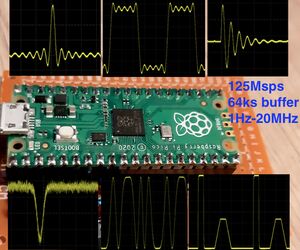
Arbitrary Wave Generator With the Raspberry Pi Pico
"Just two weeks ago, the pico, a new microcontroller, the pico, was released by the Raspberry Pi Foundation, well known for the incredibly successful series of Raspberry Pi single-board computers. The new microcontroller uses a brand new chip, designed in-house, the RP2040. It has two 32-bit cores running by default at 125MHz. It has been criticised for not having Wifi or Bluetooth, and no hardware floating point math. But it has a very fast internal bus and powerful peripherals. It has been designed for makers and has very strong support: it was released with 6 detailed datasheets and a beginners guide book, which is available free of charge as pdf." [...]
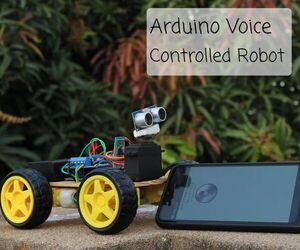
Arduino Voice Controlled Robot
"Over the years as technology advanced and grew at a tremendous pace, so did the horizon of ideas and creation in our mind. If we look a few years back, a teenager like me would dare think about creating a robot that would operate listening to their voice and follow the given commands. All they could do was dream about making such a fancy robot and let the idea pass from their mind. But with the help of today's technology, those great ideas are no more left being dreams but are coming true. Having not to deal anymore with complex circuits, Arduino gives us a very simple approach into building projects that were once impossible to make unless you were a genius and had all the materials required into making such a project. In this Instructables, I have accomplished a project that was once a dream to me." [...]

Homemade Bandsaw by DIY Enthusiast
"Hey, if you don’t know me, I am an all-around DIY enthusiast that makes all kinds of projects. But making DIY tools is something special for me. The process of figuring out how it should work, designing, building, and seeing them in action is what makes me love this so much. So I designed and made my first 8-inch bandsaw with variable speed-control, soft-start function, 45-degree tiltable table, and adjustable dust collection port. I am not a pro in fields like woodworking, electronics, or 3D printing, I just love making stuff. My goal of this instructable/video is to show step by step building process that combines those fields and that you don’t need to be a pro with a decked-out workshop to make projects like this." [...]

Laser Projected Asteroids on the ESP32
"A version of the classic arcade game Asteroids using a laser projector running on the ESP32. I've created a version of the classic arcade game Asteroids and got it running on the ESP32. The game is displayed using a laser which is directed using mirrors. You can find kits on eBay (search for laser galvo). I've 3D printed a "game controller" with 4 arcade-style buttons and a rotary controller which controls the direction of the ship. The game is implemented using the Esspressif IDF using PlatformIO to build and deploy." [...]

There oughta be a macro keyboard
"I built a dynamically assignable macro keyboard with an e-ink screen. What does that mean? Well, it is a device that pretends to be a regular keyboard, but the meaning of each button changes depending on which application you currently try to control. What does it do? As you can see from the pictures, it is a device with eight buttons, a large dial and a display and it is plugged into a PC via USB. There it registers as a regular keyboard and sends individual key events or sequences of keypresses if I push one of the buttons." [...]

DC, Servo, Stepper Motors and Solenoids with the Pico
"You've got an RP2040 Pico and some motors and a burning desire to get them working together. This guide is here for you! In it, you can pick among different types of motors/drives and learn how to wire them up and control them using CircuitPython! With lots of pins, and a "it's OK if it breaks" price, the Pico is great for robotics projects, and thanks to CircuitPython its also incredibly easy to use DC motors, Servo motors, Stepper motors and Solenoids. Let's get this motor party started! " [...]
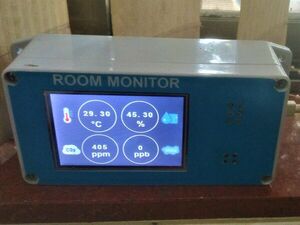
Portable Room Monitor
"A simple low cost room monitor which measures temperature, humidity, carbon dioxide level and VOC. This data is accessible via the internet. Back in 2017, I had got a kick of learning Arduino, although I was from a Computer Science background. As a final year engineering project I had developed a simple weather monitoring system using IoT where I had used multiple sensors and Arduino UNO as well as a NodeMCU. The data was sent to a ThingSpeak interface to monitor the data. On gaining confidence from the previous project, I decided to give a shot in developing a portable room monitoring device for my room, to measure the air quality level of my room." [...]

Wio Terminal: Arduino Smart Doorbell
"Turn your Wio Terminal into a doorbell with automatic motion detection and remote notification capabilities! This project builds a doorbell that automatically detects the presence of movement, then notifies you on your mobile phone wherever you are. You can also follow along with any Arduino-compatible development board. Introduction to the Smart Doorbell Project There are many reasons why you might want a smart doorbell over the conventional one. For example, you might have a baby in your home and you don’t want your dog to bark and wake her up every time a visitor comes by. Or, you might simply want to know when there are visitors when you aren’t home!" [...]
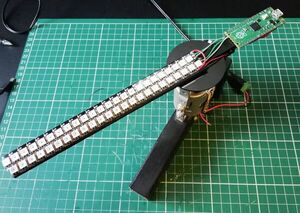
POV Display Using Raspberry Pi Pico
"I made a full color POV display using Raspberry Pi Pico and DotStar LED tape. I made a full color POV (persistence of vision) display using Raspberry Pi Pico, wireless charging module and DotStar LED tape. High-speed display is possible with PIO of Raspberry Pi Pico. Constitution LED tape, SPRESENSE and reflectance sensor are mounted on the rotating part, and LED tape uses DotStar. Using the wireless charging module, the power supply to the rotating part was carried out wirelessly. POV Display Device I used two Dotstar LED tapes controlled by hardwear SPIs (SPI0, SPI1)." [...]

Magic Dome
"Francisca Molero Luque, Dolores Martn Cabrera and Laura Meja Ospina, students of 'Creative Electronics', a Beng Electronics Engineering module at the University of Mlaga, School of Telecommunications. We decide to make as final project a derivation of Interactive Geodesic LED Dome. Supplies: - NeoPixel Digital RGB LED Strip - IR sensors - 470 Ohm and 10K Ohm resistor - 47K Ohm potentiometer - NPN transistor - 8-channel 74LS151 - Buzzer - 15W power supply - Arduino UNO - Prototype boards - Cables - DIP socket - Push buttons - Plywood - PLA - Soldering iron, flux and tin - Spray paint - Multimeter - Electric jigsaw machine - Drill - Sandpaper" [...]
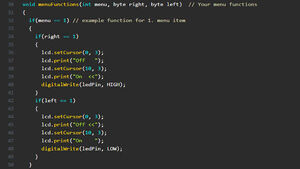
Dynamic arduino LCD menu
"The following Dynamic Arduino LCD menu is easy to use, easy to edit, expand. You can add as many menu items as you want. Just enter the menu items, write the corresponding function and you’re done. All this at the beginning of the arduino sketch, you don’t have to search the code for where to paste the code snippets. It can be a good solution for both beginners and advanced users if you need to create an LCD menu quickly. Proper external power is highly recommended, the USB port power is low to power the LCD display and the Arduino UNO." [...]
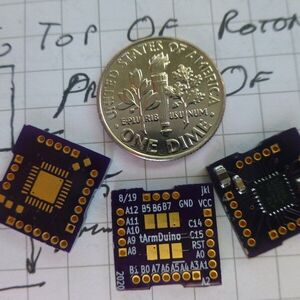
Tiny Arduino for Hackers
"A dime-sized, ARM-based Arduino complete with a programming/development system. Hardware and software design to make a tiny Arduino are shown. Project Logs present project details. Here is how this project unfolds: First Version - STM32L031G6 My first design, and what I learned that drove me to a second version. Second Version - STM32L071KBU Second design. Includes both the tiny version (tArmDuino) and the breadboard version." [...]
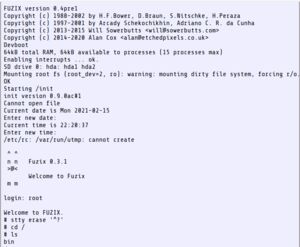
Fuzix on the Raspberry Pi Pico
"So, my new Raspberry Pi Picos (two of them) arrived just as I was finishing up the ESP8266 Fuzix port, and naturally I had to port Fuzix to this too. I didn’t video this one, which is a shame as it would probably have been a more interesting watch. The Pico is an interesting device: two Cortex M0+ cores running at approximately 130MHz, overclockable up to lots; 2MB of NAND flash on chip; 269kB of RAM; and a large collection of interesting hardware, including two high-speed IO coprocessors which allow you to do some really interesting things. The Fuzix port only uses one core but it runs really nicely on it, which RAM to spare. Compared to the ESP8266 it seems a little slower, but I haven’t touched the overclocking settings yet. Performance is still completely adequate for an interactive Unix." [...]
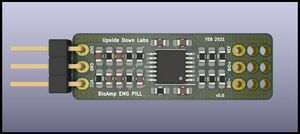
BioAmp EMG Pill
"BioAmp EMG Pill is a small and elegant Electromyography board which you can use with any micro with an ADC, tested with Arduino Nano. " [...]

PAD HERO (Guitar Hero Using Arduino)
"A group of three students present you PAD HERO, our Arduino based Guitar Hero game. This project was submitted to 'Creative Electronics', a Beng Electronics Engineering module at University of Mlaga, School of Telecommunications (https://www.uma.es/etsi-de-telecomunicacion/). The aim of this Project was to replicate the popular game Guitar hero on Arduino. We wanted to keep it as simple as possible so we gave it the retro/arcade touch it has. The setup uses a SAV MAKER I as a controller, an alternative to Arduino Leonardo, assembled by us. We hope you enjoy this instructable as we did enjoy making it!" [...]

Bitbanged DVI on the RP2040 Microcontroller
"This project stems from a stupid idea I had during RP2040 bringup. I couldn't convince myself the idea was too stupid to work, so I took a leap of faith on it, and the results are documented here. RP2040 was designed to run at 133 MHz, but we found (without too much surprise) that typical silicon can be pushed further. In fact, there was overlap between the maximum system clock, and the TMDS bit clocks of slower DVI video modes. We had done great stuff with VGA on the FPGA platform, which ran at 48 MHz, but wouldn't it be absurd and wonderful to connect your microcontroller straight to an HD TV with no other electronics in between? This seemed unlikely to work out, but I stayed up at night playing around with assembly loops, and I could not convince myself that DVI was out of reach." [...]
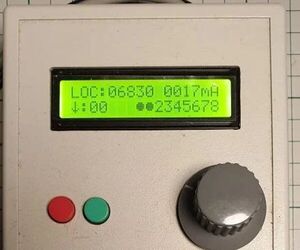
ESP8266 DCC Controller
"This is a DCC model railroad controller based on the nodeMCU ESP8266 IOT module. It makes use of other modules commonly available on eBay for the Arduino such as a 1602 LCD display, keypad, jogwheel and I2C backpacks. The controller implements the JMRI protocol over WiFi and you can control your locomotives directly from one or more smartphones. You will need to download the free EngineDriver (Android) or WiThrottle Lite (Apple) App to your phone or tablet. The system was designed around low cost components and can run 8 locomotives simultantously drawing a maximum 4 Amps. There are various build options." [...]
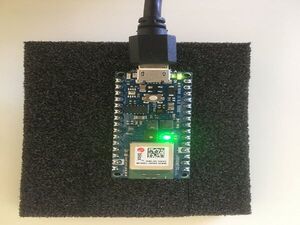
Controlling Traffic Lights with Micro Speech
"A TensorFlow Lite Micro Speech model that detects wake words and turns on a different coloured LED light to emulate traffic lights. Introduction and Motivation Machine learning typically involves lots of computing power, and these are usually in the form of a large data center with GPUs and the costs of training a deep neural network can be astronomical. The emergence of tiny neural networks, which are as small as 14 KB, opens a plethora of doors to new applications that can analyze data right on the microprocessor itself and derive actionable insights (Warden and Situnayake, 2019). This saves time and prevents latency because we do not have to transmit data to a cloud data center for it to be processed and wait for it to come back (Warden and Situnayake, 2019). Such a phenomenon is called Edge Computing and allows for data to be processed and computed on the device that it is stored (Lea, 2020). Learning Process: The Model Training For starters, I had no idea what edge computing or what an Arduino was before I started this project." [...]
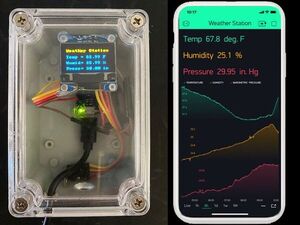
Tiny Internet Weather Station
"An easy to build simple weather station that connects to your smartphone via WiFi and Blynk. Story There are a lot a apps out there that allow you to connect your smartphone to the Internet of Things. I have tried a bunch of them and have usually been disappointed. Not so with Blynk! It is really flexible, has a beautiful user interface, works with all kinds of IoT platforms, and runs on both Android and iPhone. It is also free for hobbyists!" [...]

Race Start Timer and Speed Measure for Hot Wheel Car Models
"Start sequence to race, then show winner for Hot Wheels type cars. Displays total race time, both car speeds and winning difference in ms. My Hot Wheels Race Start and Finish Line Timer project is designed to show the winning car in a 2-car race contained in a child-friendly, easily transportable self-contained case that is less than 13x10x12cm. Simply place the unit over the tracks and connect a USB power supply. No additional set up is needed. The race timer starts with a grand prix style audible start sound and flashing light sequence. Once the lights go out, the race starts and the time is measured." [...]
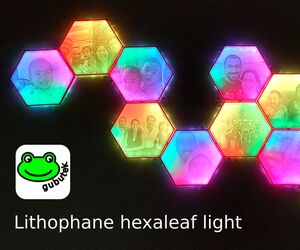
Lithophane LED Modules (nanoleaf Alternative)
"In this project, I used led strip and lithophane photo to make decoration panels. Each module is a hexagon panel and can be used to make different shapes (nanoleaf alternative). For each light panel, you will need 0.5m of LED strip, the hexagon frame for the LED, the lithophane photo the photo frame. If you don't want to use lithophane photo, you can print the photo.stl file. It is a flat photo and works like a diffuser. " [...]
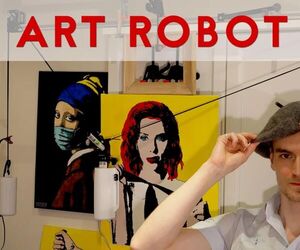
Build a Robot That Creates Art
"In this project I'm showing you how I made my own art robot. The whole concept is to illustrate how we as humans can work together and collaborate with machines and robots to create something new. Both the art style and ethos of the project was inspired by the great pop art artist Andy Warhol. Warhol was among other things fascinated by commoditization and mass production. This inspired his own art work both in subjects, like Coke bottles, Marilyn Monroe, Campbell Soup cans, and in method - as he used silk screen printing to be able to churn out paintings and art work in his studio The Factory. I might be severely overstepping, but I like to imagine he would be proud of a robot making art in the style he helped popularize." [...]
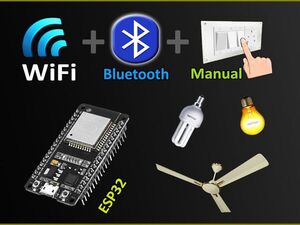
WiFi + Bluetooth + Manual Switch control 8 relays with ESP32
"Control 8 relays with WiFI + Bluetooth + Manual Switch using ESP32 and Blynk App. Explained with circuit & source code. In this IoT project, I have shown how to make an ESP32 WiFi Bluetooth Home Automation system with Manual Switch using Blynk App to control 8 home appliances with and without internet. If the internet is not available, then you can control the home appliances from mobile Bluetooth and manual switches. During the article, I have shown all the steps to make this smart home system. This ESP32 control smart relay has the following features: Control home appliances with Blynk App if WiFi is available." [...]

tCam-Mini: An ESP32-Based Radiometric Thermal Imaging Camera
"A simple-to-build streaming radiometric thermal imaging camera with powerful desktop software. tCam-Mini is a small wireless streaming thermal imaging camera I designed to make it easy to get and use radiometric data from a Flir Lepton 3.5 sensor. I am interested in the radiometric data because it includes the temperature of every pixel in the scene allowing all kinds of interesting thermographic analysis. Of course that data can also be turned into the beautiful false-color images everyone associates with thermal imaging. I designed a PCB but tCam-Mini can also be built using commonly available development boards and a few extra components. I describe that build here." [...]
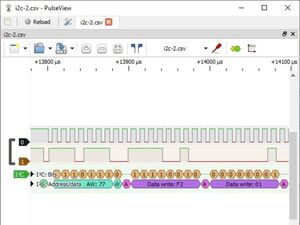
Using a Raspberry Pi Pico as a Logic Analyzer with PulseView
"The RP2040 based Pico can be used as a logic analyzer with PIO. The example be expanded to export the results to sigrock and PulseView. Background The new RP2040 process on the Raspberry Pi Pico comes with a Programmable IO (PIO) module. This module has many uses to directly control the GPIO of the board at high speed. An example that comes with the Pico shows how to use PIO to capture input on a pin as a logic analyzer. The included example prints out a simple ASCII display of the data and while interesting, it is hard to examine the ASCII printout in detail." [...]
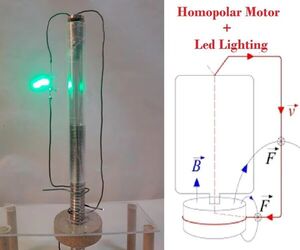
Homopolar Led Lighting
"A homopolar motor is a direct current (DC) electric motor which produces constant circular motion. This device is easy to create. A permanent magnet is attached to one terminal of a DC power supply. A conducting wire connects the other terminal to the magnet, thus completing the circuit. This wire should be free to rotate whilst always maintaining contact with both the terminal and magnet. The current (I) flowing through the wire will produce a magnetic field." [...]
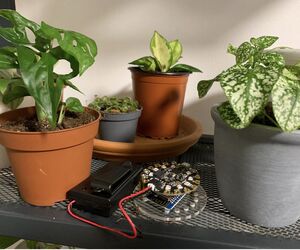
Plant Care With IOT
"The COVID-19 epidemic brought with it a new habit - house plants! the loneliness of lockdown brought people to find a link with nature using house plants. Such as many others, we started to grow plants too, to make our house a more pleasant to stay in it for a long time. Our project is meant to make house plant caring a lot more easy and efficient, with the combination of CPX, Inegromat and Blynk. We deal with four scenarios: 1. First Scenario: a push notification is sent to your smartphone if the temperature around the plant isn't optimal for them." [...]
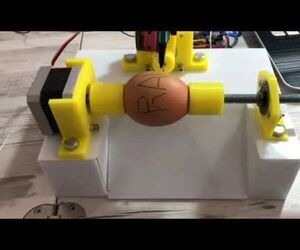
Eggbot
"Rafael Fuentes, Carmen Mara Fuentes and Carmen Prez decided to create this project that was submitted to 'Creative Electronics', a Beng Electronics Engineering module at University of Mlaga, School of Telecommunications. The project consists of making an eggbot using an Arduino Uno development board. This project was done for being a good introduction to CNC machines because you can clearly see and learn all the firmware and hardware concepts that involves them in a fun way. It was also decided to build the main frame from acrylic sheets in order to get our hands dirty in terms of the physical build. The eggbot is a friendly art robot that can draw on spherical or egg-shaped objects. Your barebone version only needs two stepper motors, a micro servo motor to lift the pen, a bearing and some threaded rod." [...]

SSD1306 With Raspberry Pi Pico
"I've been playing with the new Raspberry Pi Pico microcontroller and have been using it to drive a cheap and simple SSD1306 display with 128 x 64 pixels. This Instructable will show you how to install the necessary driver, connect up your Pico and the display, draw text, lines, rectangles and circles on your screen, bounce an icon around the screen and print a scrolling message in a Sine curve. Supplies: Raspberry Pi Pico - with legs soldered on Breadboard or Pimoroni base SSD1306 display connecting jumper wires" [...]

Drill Press Table With Dust Collection
"For me, this is one of those projects that Ive been wanting to build for years but could never seem to get around to it. Well now I have. Taking inspiration from other drill press tables Ive seen, I set out to design my own. I used the Fusion 360 design program to do so. I love this program for the amount of detail it offers and the ability to make highly detailed building plans straight from the program. And, speaking of building plans, if you are interested in the plans for this build, you can get them from my website." [...]

Water Level Indicator With Temporary Alarm & Water Flow Sensor
"There are many countries and people who depend on the water tank to get the water for their home as I am. In the lockdown, my dad keeps climbing the stairs to know the water level and to secure our home needs from water, and it is very dangerous to go up the stairs every day, so I decided to make a water level indicator to save my dad and let him see the water level on his couch. I made 6 levels of water indicator with a temporary alarm & water flow sensor. Buy or DIY, I preferred to make it by myself because it will be cheaper and has more options didn't available in the market. Supplies: This water level indicator is easy for everyone to make at home with simple materials, you need: Circuit components Box Ethernet cable or any 8 wires cable Tube Hot glue Solder iron Drill" [...]
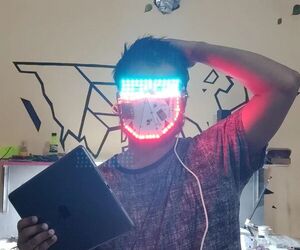
RGB Mask PCB Edition
"Hey guys what's up So this is my RGB Mask project that is made from soldering 5 PCBs together, This RGB mask has 52 WS2812B LEDs and they are controlled by an ESP8266 microcontroller module. BUT Does this work as an actual face mask? No, not really but we can wear a normal mask beneath this RGB mask and stay safe. I first made a cardboard mask and then use its measurements for making a PCB design which has solderings pads on edge of PCB. by putting PCBs together in the right order and soldering them at a certain angle, we can combine two or more 2 PCBs to create a PCB structure or shape. with this method, we can make anything with PCBs even a PCB Hat or Iron man's Helmet, we just need to follow the basic geometry and that's pretty much it." [...]
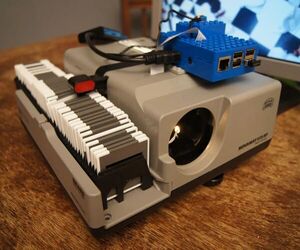
Super-fast DIY Slide Scanner
"Before digital photography entered our lives and became ubiquitous, people had their photos printed on paper, and they made slide shows. From the 1950s through to the 1970s, boring friends and family with slides of vacations or weddings was an accepted pastime. There was no internet, people didn't know any better. Although we now have Facebook and Instagram to share family photos (I'll leave it for you to decide if that is an improvement), the remnants of the Kodachrome era are still in a lot of people's attics. Boxes full of 35 mm slides are still taking up space. To remedy that, people buy a slide scanner, only to find out that scanning a big collection is a *lot* of work." [...]

Building the Simplest, Best Sounding, Yet Most Inefficient Audio Amp!
"In this project I will be showing you how to create a class A audio amp. The great thing about such amps is that they only require a few components and sound awesome. On the other hand though, their efficiency is not that great. But since I will be creating this amp for a smartphone with a USB Type-C port for powering the amp, it should be just fine. So let me show you how to calculate a design for such an amp and how to build it! Let's get started!" [...]
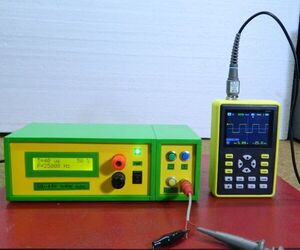
DIY Arduino Square Wave Generator Up to 1Mhz
"This is a simple square-wave generator that basically uses the TimerOne library allow you to generate a PWM signal at pin 9 in the range from about 5Hz to 1 Mhz, and you can adjust the duty cycle from 0 to 100%. Device is very simple to build and consist only a few components: - Arduino nano microcontroller - LCD Display - Three pull Up resistors - and three push buttons The pulse generator has the ability to adjust the pulse repetition period using the buttons connected to digital inputs 6 and 7 of the Arduino. 13 input pin allows you to adjust the duty cycle. " [...]

Forth computing system
"A Forth CPU and System on a Chip, based on the J1, written in VHDL This project implements a small stack computer tailored to executing Forth based on the J1 CPU. The processor has been rewritten in VHDL from Verilog, and extended slightly. The goals of the project are as follows: Create a working version of J1 processor (called the H2). Make a working toolchain for the processor. Create a FORTH for the processor which can take its input either from a UART or a USB keyboard and a VGA adapter. All three of which have been completed." [...]
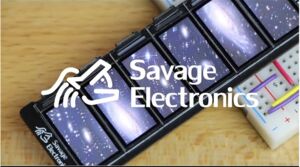
First Impressions - Raspberry Pi PICO
"Testing the examples in the Raspberry Pi Pico C/C++ SDK The Raspberry Pi Pico is a very inexpensive microcontroller compared to other brands with ARM Cortex M0+ ( This one is a dual-core ), also has one special feature only found in more expensive microcontrollers like Cortex M4 it is the Raspberry PIO which is a way to create special hardware peripherals. In my Feather MK26F board, it is called FLEXBUS, and the equivalent can be found in other microcontrollers. So the remarkable feature for me of this microcontroller are: XIP( Execute in place ) The ability to save and execute programs running on an external 2MB-16MB QUAD-SPI flash. 246Kb of RAM, that is a lot of RAM, mostly seen on mid-range microcontrollers. 133 Mhz Cortex M0+ dual-core 8 PIO, Programmable IO State machines. USB-Bootloader with SWD debug capabilities." [...]
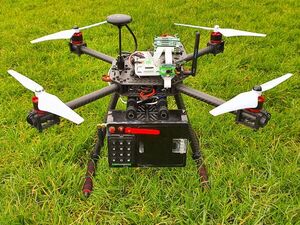
CovidTestDrone
"CovidTestDrone enables self-administered COVID-19 tests to be delivered within minutes to patient’s homes via drone delivery. The year is 2021, a year that I am quite sure will be imprinted in our history books. This year and the previous have been unlike any we experienced before; we were struck by a blight that nobody saw coming, a virus that threatened our species. This virus was a testimonial to the power of the world, the dominance of nature over humanity, the fact that we are merely chess pieces played by higher orders in the game of life. Before the pandemic we were all living our lives, stuck in our routines. But the pandemic managed to change the world’s priorities dramatically." [...]

Breadboard Voltmeter
"A small voltmeter that sits on a breadboard's power rails I wanted to try out the ATtiny85 and get some practice hand-soldering QFN components, so I built a basic voltmeter that sits on the power rails of a breadboard. Features * Displays power supply voltage, rounded to the nearest volt * Reversible - cannot be inserted incorrectly * Low power consumption - below 3mA * Small - only takes up a single 2x5 block of pins on a standard breadboard power rail Some things I'd do differently next time: Include a programming header for the ATtiny85. I had to solder it some 30 awg wire-wrap wire to existing PCB pads to program the ATtiny before adding any other components. Use regular 0603 resistors instead of a resistor network. I ended up ordering the wrong size network and had to use discrete resistors anyway. Show non-integer voltages by adjusting the relative brightness of adjacent LEDs." [...]
Secção Videos
Videos interessantes.
That's all Folks!



